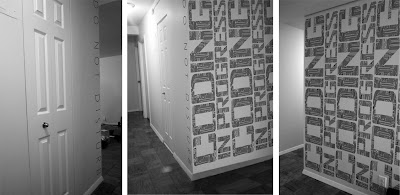Install 1: There's An Election Coming Up... Select a segment from this week's Daily Show or Colbert Report having to do with the 2012 Election and illustrate the message graphically on the wall. Draw us in with humor, consider hierarchy, voice and image carefully.
Install 2: Its Serious Take us deeper with facts/data on 1 major election issue (Jobs, Taxes, Energy, Education or Healthcare). Make us care. Utilize compelling content — both text and imagery.
Install 3: VOTE! Now get out the vote. You must use the text "Vote Tuesday, November 6" but may choose to include additional text and/or imagery to enhance your specific message. Your goal should be to create the most compelling, densely collaged visual possible — stretching your creativity to the limit as you embrace the physical layering of all accumulated material.
Postmortem Poster: VOTE! Convert your final hallway installation into an 11"x17" poster. Use as much or as little of the physical design as you'd like — embrace the strengths, exclude and/or improve the weaknesses. Create a compelling piece of lasting design and remember that this is the only thing that will remain...
Felita + Jiani: Installation Process
Felita + Jiani: Final Poster
Bethany + Mansi: Installation Process
Bethany + Mansi: Final Poster
Hannah + Craig: Installation Process
Hannah + Craig: Final Poster
Elizabeth + Shubha: Installation Process
Elizabeth + Shubha: Final Poster
John + Tommy: Installation Process
John + Tommy: Final Poster





































